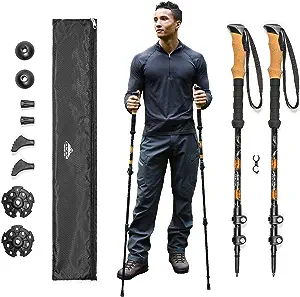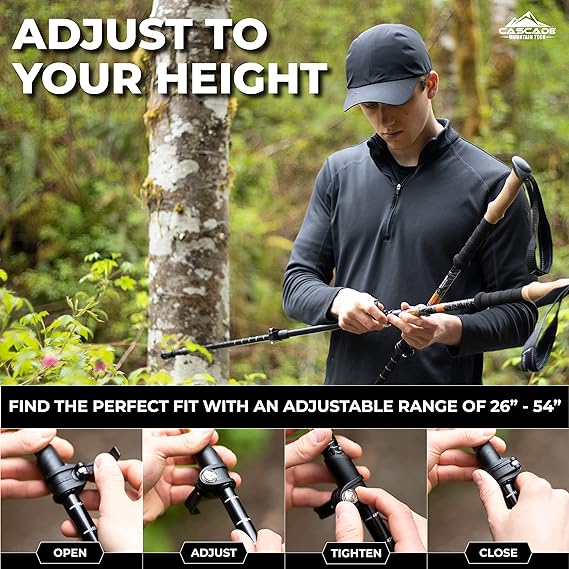Discover the benefits of sweatbands for your fitness routine. Enhance your performance and stay comfortable with these stylish and functional accessories.


Nordic walking is a popular form of exercise that originated in Finland and has gained popularity worldwide. This low-impact, full-body workout involves using specially designed Nordic walking poles to enhance the walking experience. In this article, we will explore the benefits of Nordic walking poles, how to choose the right ones, and tips for using them effectively.
Nordic walking poles, also known as trekking poles or fitness walking poles, are similar to ski poles but with a few key differences. They typically have ergonomic handles and adjustable straps to ensure a secure grip. The poles are made from lightweight materials such as aluminum or carbon fiber for easy handling and durability.
Nordic walking poles offer a range of benefits that make them a popular choice for fitness enthusiasts:
Using Nordic walking poles engages the upper body muscles, including the arms, shoulders, and core. This increases the intensity of the workout, resulting in a higher heart rate and improved cardiovascular fitness.
The use of Nordic walking poles activates more muscles compared to regular walking, leading to a higher calorie burn. Studies have shown that Nordic walking can burn up to 20-46% more calories than walking without poles.
The act of using Nordic walking poles encourages an upright posture, which helps to align the spine and reduce strain on the lower back. The poles also provide additional stability, making it easier to maintain balance while walking.
Nordic walking is a low-impact exercise that puts less stress on the joints compared to activities like running or jogging. The use of poles helps to distribute the impact evenly across the body, reducing the risk of injuries.
Unlike regular walking, Nordic walking engages the muscles of the upper body, including the arms, shoulders, and core. This provides a comprehensive full-body workout that targets multiple muscle groups simultaneously.

When selecting Nordic walking poles, there are several factors to consider to ensure you choose the right ones for your needs:
The length of the poles is an important consideration as it affects your walking technique and comfort. To determine the correct pole length, stand upright with your arms relaxed at your sides. Bend your elbows at a 90-degree angle and have someone measure the distance from the ground to your hands. This measurement will give you an idea of the optimal pole length for your height.
Nordic walking poles are typically made from aluminum or carbon fiber. Aluminum poles are more affordable and durable, making them a popular choice for beginners. Carbon fiber poles, on the other hand, are lighter and provide better shock absorption, but they tend to be more expensive.
The grip and strap of the Nordic walking poles should be comfortable and provide a secure hold. Look for ergonomically designed grips that fit comfortably in your hands. The straps should be adjustable and allow for easy release when needed.
The tip design of the poles is another important consideration. Most Nordic walking poles come with removable rubber tips for walking on paved surfaces. Some poles also have interchangeable tips for different terrains, such as snow baskets for winter walking.
Here are some tips to help you use Nordic walking poles effectively:
When using Nordic walking poles, it’s important to maintain a proper technique. Start by planting the poles slightly behind your body and push off with the poles as you stride forward. Keep your arms relaxed and allow them to swing naturally.
If you’re new to Nordic walking, start slowly and gradually increase your pace and distance. Focus on maintaining proper form and rhythm to get the most out of your workout.
For maximum benefit, use the Nordic walking poles consistently throughout your entire walk. Engage your upper body muscles by actively pushing off with the poles and maintaining a steady rhythm.
Before and after your Nordic walking session, make sure to warm up and cool down your muscles. This helps to prevent injuries and allows your body to adjust to the exercise.
As with any form of exercise, it’s important to stay hydrated during Nordic walking. Carry a water bottle with you and take regular sips to replenish fluids.
If you’re new to Nordic walking or have any underlying health conditions, it’s always a good idea to consult a fitness professional or healthcare provider before starting a new exercise routine.

When it comes to Nordic walking, choosing the right time and place to engage in this activity can greatly enhance your experience. Here are some tips for selecting the optimal time and place for Nordic walking:
Consider the time of day when planning your Nordic walking sessions. Early morning or late evening can be ideal, as the weather is usually cooler and there are fewer people around. However, choose a time that works best for your schedule and when you feel most energized.
Check the weather forecast before heading out for your Nordic walking session. Avoid walking during extreme weather conditions such as heavy rain, thunderstorms, or extreme heat. Dress appropriately for the weather, wearing layers that can be easily removed or added as needed.
Choose a terrain that suits your fitness level and goals. If you’re a beginner, start with flat or gently sloping surfaces. As you become more experienced, you can gradually progress to more challenging terrains such as hills or trails. Be mindful of uneven surfaces and obstacles to prevent accidents or injuries.
Prioritize safety when selecting a location for Nordic walking. Choose well-lit areas if you’re walking in the early morning or evening. Stick to designated walking paths or trails that are free from traffic. If walking on the road is necessary, walk facing oncoming traffic to ensure visibility.

Nordic walking can be a great addition to your existing fitness routine. Here are some tips for incorporating Nordic walking into your fitness regimen:
Set specific goals for your Nordic walking sessions. Whether it’s increasing your distance, improving your speed, or building endurance, having clear goals can help you stay motivated and track your progress.
Make Nordic walking a regular part of your fitness routine by scheduling dedicated sessions throughout the week. Aim for at least three to five sessions per week, with each session lasting 30 minutes to an hour.
Consider combining Nordic walking with other exercises to create a well-rounded fitness routine. For example, you can alternate Nordic walking with strength training or yoga sessions to work different muscle groups and prevent boredom.
Keep track of your progress to stay motivated and see how far you’ve come. Use a fitness tracker or smartphone app to monitor your distance, speed, and calories burned during each Nordic walking session.
If you prefer a social aspect to your workouts, consider joining a Nordic walking group or taking a class. This can provide additional motivation, accountability, and the opportunity to learn from experienced instructors.
When starting out with Nordic walking, it’s important to be aware of common mistakes and avoid them to maximize the benefits of this exercise. Here are some common mistakes to watch out for:
Avoid gripping the poles too tightly, as this can lead to muscle tension and discomfort. Hold the poles with a relaxed grip, allowing your hands to move naturally with each stride.
Maintain an upright posture while Nordic walking and avoid leaning too far forward. This can strain your lower back and lead to discomfort. Keep your back straight and engage your core muscles to support proper alignment.
Avoid overstriding, which is taking excessively long strides. This can put strain on your joints and increase the risk of injury. Instead, focus on taking shorter, quicker strides and maintaining a consistent rhythm.
Ensure that you’re actively engaging your upper body muscles while Nordic walking. Push off with the poles and use your arms and shoulders to propel yourself forward. This will help to distribute the workload evenly and provide a full-body workout.
Don’t forget to breathe deeply and rhythmically while Nordic walking. Inhale through your nose and exhale through your mouth, allowing your breath to flow naturally with each stride. This will help to oxygenate your muscles and enhance your endurance.
Like any product, there are pros and cons to using Nordic walking poles. Here are a few to consider:
Very good quality, very comfortable grip.The flip locks (“quick locks”) give you reliable control and I strongly prefer them to the screw-together kind. Comfortable cork handle. On a first outing, absolutely no problems. There’s a full set of rubber tips included (3 kinds, plus the integrated carbide tip itself).My use:Going uphill: I carry one stick (rather than strapping it to my bag) in a shortened position. That lets me brace on things without touching them or catch myself falling “up”.Going downhill: Extended to normal for my height + a little bit and I use it ahead of me to take strain off my knees and provide stability on loose surfaces.Level ground: I typically don’t use.These are “basic” but everything you need in a hiking pole.You’re saving a lot of money and not losing anything by going with these instead of the big national brand-names. I would only use those (national brands) if you specifically need the ultra-compact design of “Z” hiking sticks, need a particular kind for your tent, or are sold on carbon-fiber’s few ounces less weight.I usually fly with only one stick unless it’s going to be particularly strenuous or snowy.For my fellow travelers, note the sticks WILL disaassemble (easily) to fit in a 22″ rollaboard diagonally. It would probably be tight in a 22″ spinner (which has a shorter body), and would not fit at all in a “international sized” carry-on.(important considering how much more Z-frame collapsible hiking sticks cost)Highly Recommended.

A: Nordic walking poles can be used by people of all fitness levels. However, if you have any underlying health conditions or injuries, it’s best to consult a healthcare professional before starting a Nordic walking routine.
A: Stand upright with your arms relaxed at your sides. Bend your elbows at a 90-degree angle and have someone measure the distance from the ground to your hands. This measurement will give you an idea of the optimal pole length for your height.
A: Nordic walking poles can provide relief for people with knee or joint pain. The poles help to distribute the weight more evenly and reduce the impact on the joints, making it a low-impact exercise option.
A: Yes, Nordic walking poles can be used on various terrains, including paved surfaces, trails, and even snow. Some poles come with interchangeable tips for different terrains.

Nordic walking poles are a versatile and effective tool for enhancing your walking routine. By choosing the right poles, using proper technique, and incorporating Nordic walking into your fitness regimen, you can enjoy the numerous benefits of this full-body workout. Avoid common mistakes, stay consistent, and have fun exploring new terrains and challenging yourself with Nordic walking. With dedication and perseverance, you can achieve your fitness goals and improve your overall health and well-being.
Nordic walking poles are versatile and effective tools that can enhance your walking experience and provide a full-body workout. They offer numerous benefits, including improved cardiovascular fitness, increased calorie burn, improved posture and balance, and a low-impact exercise option. By choosing the right poles, using them correctly, and gradually incorporating them into your walking routine, you can enjoy the many benefits of Nordic walking. Remember to consult a professional if needed and stay consistent with your practice to see the best results.